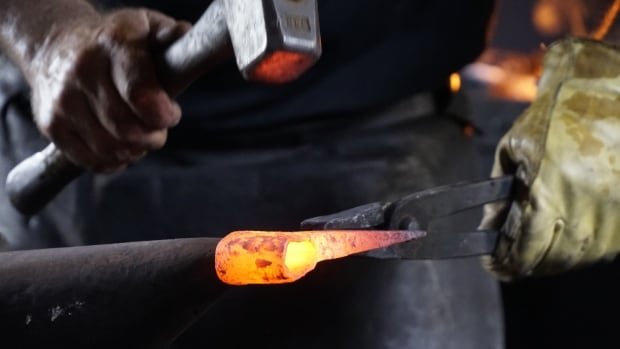This Montrealer forged medieval axes used to rebuild Notre-Dame cathedral
Montreal blacksmith forging 12th century tools to rebuild Notre-Dame in Paris1 day agoDuration 2:03A Montreal blacksmith is forging the same type of tools — axes — that were used to build the original Notre-Dame de Paris. They will be used to help rebuild the cathedral's roof and spire, which were destroyed in a catastrophic fire in 2019.The axe head, heated by the flames of Mathieu Collette's forge, glows white hot among the coals. Collette, a blacksmith who uses traditional methods to fashion tools from iron and steel, pulls it from the fire and, with a series of hammer blows, moulds it into shape. Meanwhile, in France, possibly at this very moment, carpenters are using axes he fashioned to carve logs of red oak into roof trusses for Notre-Dame-de-Paris, the world's most famous cathedral. The axes had to be as close as possible to the originals used by the carpenters who first built the cathedral in the 12th and 13th centuries — so that the new wood beams would bear the same markings

The axe head, heated by the flames of Mathieu Collette's forge, glows white hot among the coals.
Collette, a blacksmith who uses traditional methods to fashion tools from iron and steel, pulls it from the fire and, with a series of hammer blows, moulds it into shape.
Meanwhile, in France, possibly at this very moment, carpenters are using axes he fashioned to carve logs of red oak into roof trusses for Notre-Dame-de-Paris, the world's most famous cathedral.
The axes had to be as close as possible to the originals used by the carpenters who first built the cathedral in the 12th and 13th centuries — so that the new wood beams would bear the same markings as the old.
Collette and the other toolsmiths who went to France to help with the project were uniquely positioned to make them.
"We're the only ones left," Collette said in an interview this week at his Montreal forge, located in an old pump house in the Peel Basin.
"We made the axes the same way, using techniques, materials and tools of the time."
After a 2019 fire destroyed part of its roof, walls and spire, officials in France decided to reproduce the church exactly as it had been built some 800 years ago.
It's an undertaking that requires meticulous attention to detail.
To know what types of axes to make, Soumia Luquet, the director of the Maison Luquet, a traditional workshop near Munster, France, and her team analyzed the markings that remained on wood oak beams salvaged from Notre-Dame. They also looked at old engravings that showed workmen of the time hoisting axes and using tools.
It was a forensic investigation, of sorts, as they tried to create axes which, in the hands of modern craftspeople, would leave the same marks on the wood as those of the 13th century.

They decided on five models of axes — some built for chopping, others for finer, finishing work. But to make enough for the team of craftspeople, they needed to make multiple replicas of each axe, 60 in total.
Given that it takes nine to 14 hours to make one axe, Luquet knew they needed additional manpower.
Enter Collette, who, in the world of toolsmithing, is seen as a master.
Toolsmithing "disappeared from history" with industrialization Luquet said, "and Mathieu is one of the first of this generation who chose to go to that job."

Collette arrived in France in October 2022 and, for weeks with little sleep, he worked alongside a small group of toolsmiths. Shoulder to shoulder, working in the 50 C heat of the forge, surrounded by fire and the noise of hammers striking iron, they fashioned raw iron ore into the axes, which upon completion, were sent to the carpenters.
"I think that we still can't believe what we have done," Luquet said. "You know in a way that you left a part of you in history."
In a way, Luquet said, the fire gave them the opportunity to build a new knowledge base, to relearn an art that was lost to history, and, as one of their team put it, to rebuild the cathedral, destroyed in a fire, with the fires of their forges.
"This is a lifetime project," Collette said. "I'm so sad that the church burned. It should never have happened. But actually, I'm very proud."
Collette sees it as a spiritual undertaking — his role not as protector of a lost art, but as one of the first of a new generation of toolsmiths. Work on the cathedral, while important, is a way to show the public what role his craft can play in the context of a changing climate and a need to reduce waste.
"It's important to have edged tool blacksmiths today," he said. "All society has been developed around the capacities of the blacksmith."
On a recent day at his forge, known as Forges de Montreal and home to a small museum where Collette teaches his art, he worked on a Biscayne axe head, the type used by fur traders in the 1700s. Collette turns some of these old axe heads, rusted and corroded, into shining, freshly sharpened tools that can be used again.
When the metal is still hot after he has hammered and trimmed it to the right shape, he places his stamp and with a strong blow, leaves his mark on the iron.
It's essentially the end of a labour-intensive process which stands in stark contrast to modern industrial techniques. Collette's tools last not for decades, but for centuries or even longer.
"This is the value of a traditional blacksmith is to help the community," Collette said.
"I find myself happier if I'm helping people."
What's Your Reaction?















